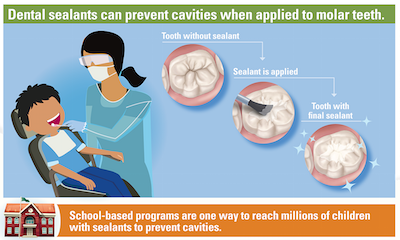5 reasons why your kids need dental sealants
We know the rules about teeth: brush twice a day, floss regularly, limit sweets. When it comes to our kids, those things may be easier said than done, but in general we know what we have to do.
There may be another aspect of kids’ dental health, though, that you don’t know much about: dental sealants. Ever heard of them? I’m not sure I had until recently, and I’m probably not alone.
What are dental sealants?
Dental sealants are thin coatings that are painted on the surface of the back teeth (molars) that can prevent cavities for several years. Sealants don’t eliminate the need for brushing and flossing, but they do provide some extra protection for those hard-to-reach places in the crevices of the back teeth where most chewing takes place.
Why should I consider dental sealants for my child?
-
Dental sealants prevent 80% of cavities in the back teeth where most cavities occur.
-
School-aged children without sealants have 3 times more cavities than those with sealants.
-
Cavities are painful, and the treatment for cavities such as crowns or dental fillings are often costly, invasive and can cause pain or anxiety for many patients.
-
Sealants are a quick, painless and cost-effective way to prevent cavities.
-
Dental sealants are covered by many health insurance plans, as well as Medicaid and CHIP (Children’s Health Insurance Plan). They also may be available through local community health centers, health department clinics and community dental providers.
What should I do?
 Once your child has gotten their first set of molars (somewhere around 6 years of age), talk to your dentist at your child’s regular dental checkup and ask whether sealants are right for your child.
Once your child has gotten their first set of molars (somewhere around 6 years of age), talk to your dentist at your child’s regular dental checkup and ask whether sealants are right for your child.
Sealants are most effective if they are done soon after the molar comes in, before any damage takes place.
Your child will get a second set of molars (somewhere around 12 years of age), and the same process should occur at that time.
Reassure your child that a dental sealant is a quick, painless process. The dentist or dental hygienist will clean and dry the tooth then apply a gel to help the sealant adhere well to the tooth. He or she will then clean and dry the tooth and apply the sealant, then dry it with a special blue light. That’s it!
Sealants can often last for several years. Your dentist will check your child’s sealant at each check-up to be sure it is still effective and let you know when it needs to be replaced.







